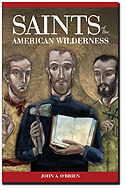 1953/2004, Sophia Institute Press, 257 pages, softcover, Catholic
1953/2004, Sophia Institute Press, 257 pages, softcover, CatholicThis is a detailed (and rather intense) history of the eight French Jesuit martyrs who worked among the Huron Indians in North America in the 1600s: St. Isaac Jogues (1607-1646), St. René Goupil (1608-1642), St. Jean de Lalande (died. 1646), St. Jean de Brébeuf (1593-1649), St. Gabriel Lalemant (1610-1650), St. Antoine Daniel (1601-1648), St. Charles Garnier (1605-1649), and St. Noël Chabanel (1613-1649).
This is an important piece of American History that is often ignored in textbooks or twisted to some degree (in part, I think, because of the animosity between the English and French early on in American History). The book is carefully detailed with an extensive bibliography and source citations throughout the text. A number of these Saints personally wrote detailed accounts of their work in North America; writings which still survive and which were extremely helpful in compiling a definitive, but accessible book. Readers will gain significant insight into the Huron and Iroquois Nations and the history of the French in Eastern Canada.
Everyone should give themselves an opportunity to be inspired by these missionaries, however. If these men were, by the grace of God, able to endure horrible living conditions, travels on foot through bitter cold, and death around every corner to bring love and hope to the peoples of North America four centuries ago, should we not be willing to do a small part in bringing Christ to the 21st century? Should we not consider that someone needs to bring love and hope to nations that are besieged by war, violence and hate; and to America's inner cities?
Read and be inspired. The stories of these heroic men might actually make the tasks and challenges of our own day seem easy!
Here is a brief portion that highlights some of their challenges and successes:
The Hurons, Brébeuf reported, "acknowledged the Commandments to be very just and very reasonable. They thought these were matters of great importance, worthy of being discussed at the councils." They admitted the logic of his conclusions about God and His attributes. But, alas, "They know the beauty of the truth," he commented sadly; "they approve of it, but they do not embrace it... They condemn their wicked customs, but when will they abandon them?" The step from belief to action was a long step, and they hesitated to pass from acknowledgement of God's existence to conformity with His laws.This book is suitable for adults and possibly older teens. Some of the accounts of torture, death and living conditions might be too disturbing for younger teens.
Among the young, progress was more marked. Three little girls had mastered the catechism so thoroughly and gave such clear evidence of interior piety that Brébeuf and Daniel judged them ready for Baptism. Inviting the whole village to attend the ceremony, which took place on the feast of the Immaculate Conception, December 8, they performed the ritual with all possible solemnity. The chapel was thronged with Hurons when the three girls, beautifully appareled and ornamented with strings of wampum and porcelain, renounced Satan and all his works and received the waters of regeneration.
The Jesuit community that morning dedicated the Huron mission to the Immaculate Conception of the Blessed Virgin. They promised to offer twelve Masses in the ensuing year toward accomplishing in Huronia the erection of a permanent church named after the Immaculate Conception. "We believe," wrote Brébeuf, "that the Blessed Virgin has accepted our humble devotions. Before the end of December we baptized twenty-eight."
Available from Adoremus Books, Aquinas and More, By Way of the Family, and Stella Maris Books

No comments:
Post a Comment